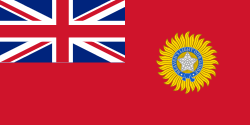Panth-Piploda Province
| Panth-Piploda पंथ पिपलोदा | |||||
| Province of British India | |||||
| |||||
|
Flag | |||||
| History | |||||
| • | Separated from Bombay | 1935 | |||
| • | Merged with Ratlam District | 1947 | |||
| Area | |||||
| • | 1941 | 65 km2 (25 sq mi) | |||
| Population | |||||
| • | 1941 | 5,627 | |||
| Density | 86.6 /km2 (224.2 /sq mi) | ||||
| | |||||
Panth-Piploda was a province of British India. It is located in present-day Ratlam District of Madhya Pradesh state of central India.
Panth-Piploda was British India's smallest province, with an area of 65 km2 (25 sq mi), and a population of 5267 (male 2666, female 2601) (1941 census).[1] It was located in the Malwa region, and consisted of several separate enclaves, bounded by the princely states of Gwalior, Jaora, and Dewas. The province was governed by a chief commissioner appointed by the Governor-General of India.
History
In 1935 Panth Piploda was separated from Bombay. Panth-Piploda was a small tract of territory comprising only 10½ villages,[2] which were held by five different thakurs. In c. 1765, the Peshwa of the Maratha Empire assigned the revenues from the villages to the family of Sambhaji Attaji, a Karadhe Brahmin. This ruling family was later known as the family of the Khandekar Pandits. The arrangement made by the Peshwa was respected by the British when they took over Panth Piploda from the Marathas in 1817. The ruling family did not have any proprietary rights whatever in these villages and were mere tankadars (recipients of the cash allowance). This cash allowance was paid to them by the Political Agent in Malwa Agency who realized it from the thakurs in whose territories the villages lay. The estate was managed by a Superintendent under the control of the Political Agent with headquarters at Kharua (also spelled as Kharwa). In 1936, there were two guaranteed tankadars, who received payments totaling Rs. 46,000. It became a province of British India in 1942. On 15 Aug 1947 it became part of independent India.
Chief Commissioners
- 1935 - 1940 Kenneth Samuel Fitze (b. 1887 - d. 1960)
- 1940 - 1942 Gerald Thomas Fisher (b. 1887 - d. 1965)
- 1942 - 1946 Walter Fendall Campbell KCIE[3] (b. 1894 - d. 1973)
- 1946 - 1947 Henry Mortimer Poulton (b. 1898 - d. 1973)
Notes
- ↑ 1941 Census of India, Table I
- ↑ Rajendra Prasad. Allied Publishers. pp. 452–. ISBN 978-81-7023-002-1 https://books.google.com/books?id=N1ZEqWRk7HsC&pg=PA452. Retrieved 17 September 2012. Missing or empty
|title=(help) - ↑ The India Office and Burma Office list 1947, vol. 56 (London: India Office, 1947), p. 32
Coordinates: 23°21′N 75°26′E / 23.35°N 75.43°E
